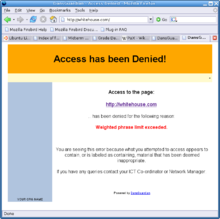Content-control software
![]()
This article or section is not written in a generally understandable way. The shortcomings are described in Discussion:Content filters. If you remove this module, please justify it on the article discussion page and add {{Done|1=~~~~}} to the automatically created project page section Wikipedia:Incomprehensible articles #Contentfilter.
![]()
This article or subsequent section is not sufficiently supported by evidence (e.g., anecdotal evidence). Information without sufficient evidence may be removed in the near future. Please help Wikipedia by researching the information and adding good supporting evidence.
A content filter is a program that is used to filter certain unwanted content (e.g. data, images, audio files, ...) before it can be transferred from one network to another.
That is why a content filter is usually located at the interface to the network input and controls the data coming into the network before it can reach the part of the network accessible to the users.
These content filters are often used by companies, governments and organizations to recognize certain content according to characteristics and properties. So that this recognized content can be blocked and excluded from the own network. The goal is to protect the users of a network from dangerous (e.g. terrorism propaganda) and illegal content (e.g. copyright infringements). It can also improve the productivity of users (e.g. less distraction) or increase the technical security of a network (e.g. against industrial espionage).
An example of the use of content filters by governments is the blocking of illegal, offensive or harmful websites.

Access to the website whitehouse.com, blocked by a content filtering program (DansGuardian)
Properties and functions
A filter that can be set in detail facilitates control over the content viewed. Partly unnoticed by the user, this system blocks or filters, for example, web pages or e-mails with regard to individual words, typical phrases, images or links. Content filters are part of the BSI recommendations for the operation of secure mail servers.
Usually, these areas are configured by means of categorization, using lists (databases), such as the rejecting blacklist or a whitelist that nevertheless allows access. Typical examples of predefined categories are pornography or right-wing extremism.
Simple content filters
Simple filters only check the occurrence of certain selection criteria. The disadvantage of using very simple filters is that every page with corresponding words is blocked. This can also block pages that use blocked words in a different context. For example, if the word "sex" is blocked in any form, not only will any page in general that uses this word - even in an innocuous context - be filtered, but possibly also the page for the village of Sexten or the Wikipedia entries right-wing extremism and random experiments. This is also called the Scunthorpe problem.
Another simple method is to block certain ports or network protocols.
Intelligent content filters
To circumvent disadvantages of simple methods, intelligent filters work with weightings and reject a page only when a certain relevance is exceeded. In addition, they also use heuristic methods and, in the case of e-mails, greylists.
In contrast to a URL filter with a high hit probability, an intelligent content filter is able to correctly assess web pages or e-mails. Likewise, URLs that are found to be good can be cached for a certain period of time to avoid the time-consuming process of checking for repeated requests.
Restrictions
Simple filters can only check URLs, texts and images classified according to certain standards. Texts that are displayed in image form can only be checked if the filter also has support for OCR text recognition. Of course, it is also only possible to a limited extent to keep "blacklists" of all undesirable pages.
Advanced systems also combine an antivirus program with the content filter in order to detect malware that has been introduced via scripts or images, for example.
Today (2014), content filters are often offered as a separate service for a fee; the service providers take over the updating of the filter lists and the intelligent filtering according to configurable criteria. Significant costs are incurred per year and Internet user.
Questions and Answers
Q: What is a filter on the internet?
A: A filter on the internet is a feature on a website that removes some kinds of content.
Q: Why is a filter used on a website?
A: A filter is used on a website to stop the user viewing or posting unwanted content.
Q: How does an internet filter usually work?
A: An internet filter usually works by stopping certain words from being used.
Q: Can filters be used to stop other types of content?
A: Yes, filters can be used to stop other types of content, such as certain kinds of pictures.
Q: Who can a filter be used to prevent from seeing certain content?
A: A filter can be used to prevent only a certain kind of user, such as children, from seeing certain content.
Q: What is the purpose of using an internet filter?
A: The purpose of using an internet filter is to restrict access to unwanted content or to prevent the posting of unwanted content.
Q: What is an example of how an internet filter might be used?
A: An example of how an internet filter might be used is to prevent children from accessing inappropriate content on a website.
Search within the encyclopedia